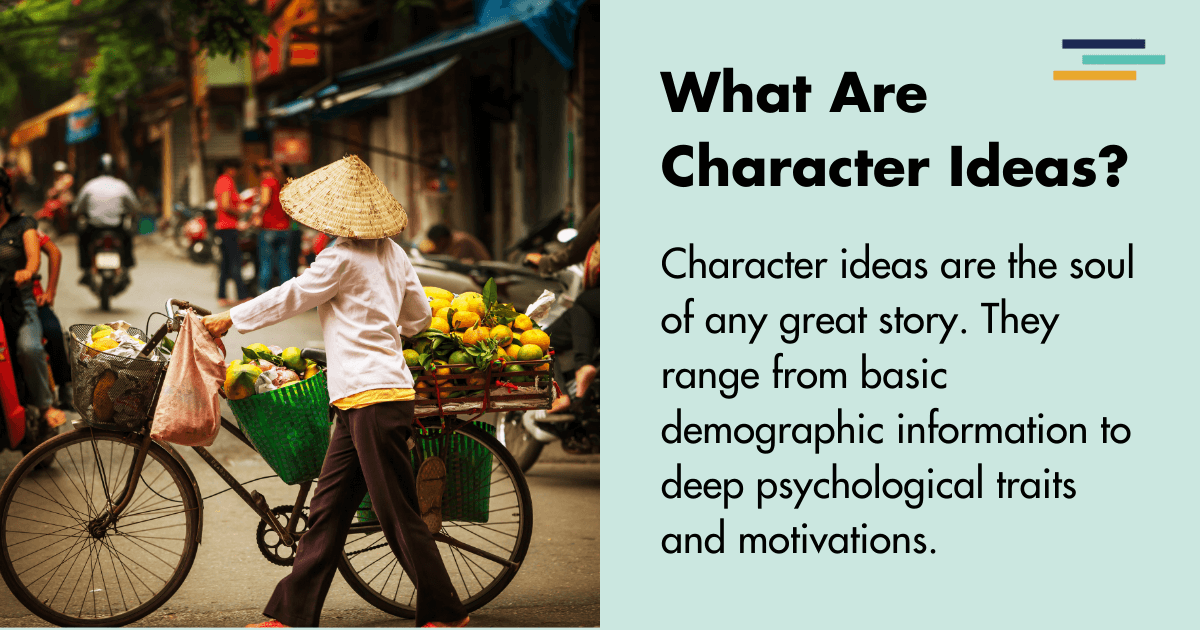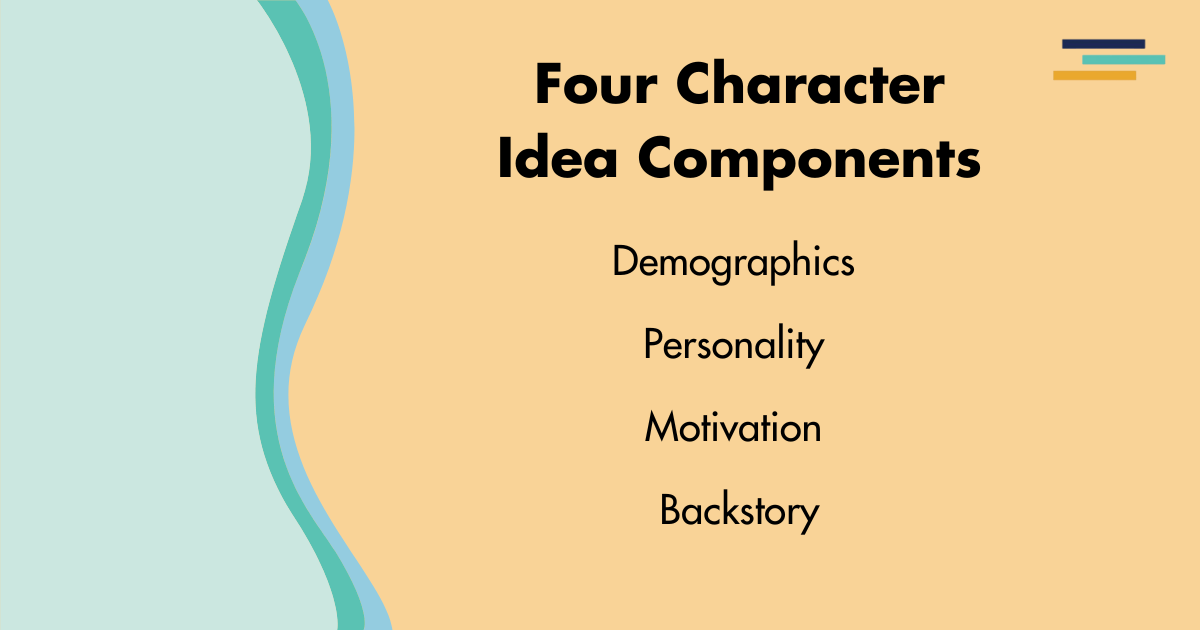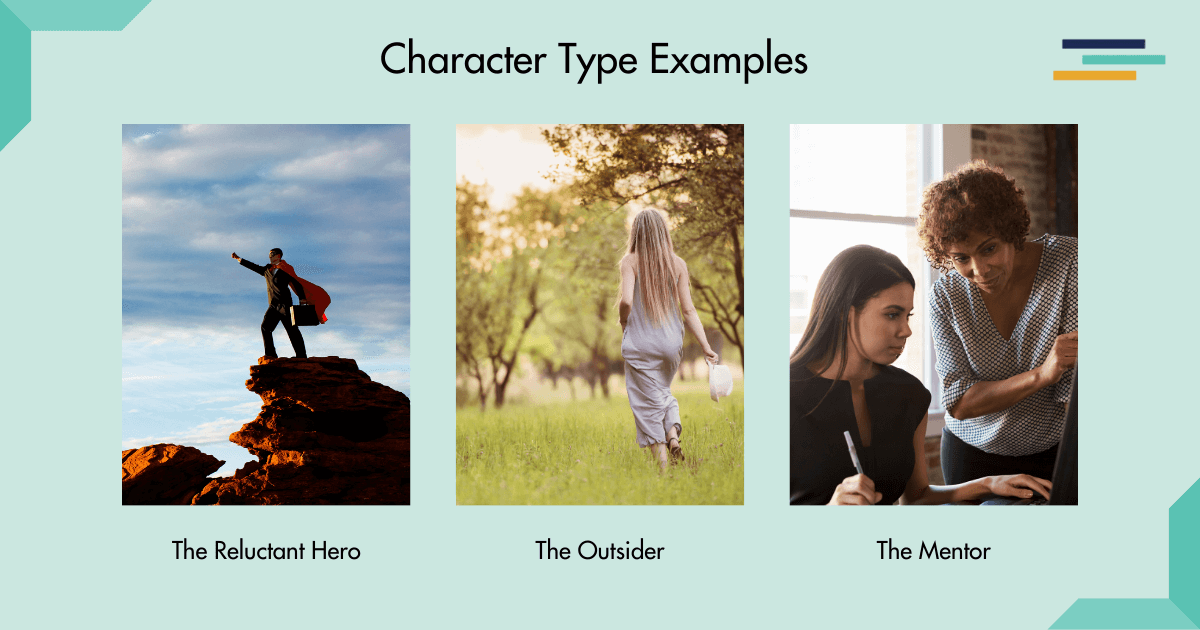
At its most basic, a good story has three things: a plot, a setting, and characters. In Fictionary, we refer to these as supergroups, and each of the thirty-eight story elements are categorized into one of these three overarching categories.
When drafting a story, whether you start with plot, setting, or character depends on your own writing style, your personality, the way your brain works, and maybe even the alignment of the stars at your time of birth.
Perhaps you’re one of those enviable souls who wake up one morning to find a fully fleshed-out persona eagerly standing by your bedside, a silent plea in their eyes that whispers, “Write about me.” If that’s you, hats off! (And also, goodness I hope you don’t write horror.)
The rest of us? Ah, we’re a different breed. We might have a world so vivid in our minds that we can stroll its streets, feel the cobblestones underfoot, and hear the distant hustle of its inhabitants. But who are we encountering on these explorations? Ah, there’s the rub.
Or maybe you’re the plot first characters later type. The master architect of intricate plots, crafting twists and turns that would make a labyrinth jealous. You’ve got the what and the where nailed down so tightly; it’s hermetically sealed. But the who? Not so much.
And then, there’s the scenario we all dread. You’ve poured your soul into a manuscript only to share it with your circle and hear the chilling feedback: “I just couldn’t connect with the characters.” Ouch. That hurts more than stepping on a Lego.
This is where character ideas become key. In many ways, an author is a sculptor of souls, a creator of beings so vibrant and real, they leap off the page to seize your reader’s imagination.
If you’ve ever wondered where to find that spark of life that transforms a name on a page into a living, breathing entity, look no further. Together, we’ll explore the caverns of personality, the landscapes of demographics, and the hidden paths of backstory, crafting companions for our journeys through the worlds we create.
What are Character Ideas?
Character ideas are the soul of any great story. They encompass a wide range of elements, from basic demographic information to deep psychological traits and motivations. At their core, character ideas are the unique combination of attributes, experiences, and personality traits that make a character feel like a fully-realized person.
Characters can range from the simplest archetypes—like the wise old mentor or the brave hero—to complex personas that feel so real, you half expect to run into them at your local coffee shop. These characters come complete with a past, a personality, desires, fears, strengths, and weaknesses that make them as multifaceted as any living person.
The magic lies in crafting characters that are both compelling and relatable. This doesn’t mean they all have to be likable or heroic. Villains and anti-heroes can be just as engaging, if not more so. After all, external conflict is one of the main driving forces of many narratives. What matters is the character’s depth, their capacity for change, and how their unique perspectives and choices drive the story forward.
Remember, every character has the potential to leave an indelible mark on the hearts and minds of your readers. So, as you craft your characters, think not only about who they are now, but who they could become. Their journey is your story’s most powerful weapon, and their transformation is its greatest reward.

Four Character Type Components
Characters are composed of demographics, personality, motivation, and backstory. By weaving these elements together in a cohesive and authentic way, you can create characters that feel truly three-dimensional.
Demographics include factors such as age, gender, race, ethnicity, sexual orientation, and socioeconomic status. Think about the various roles and identities that people adopt within society, such as their occupation, social class, or family structure. How might these factors shape a character’s worldview, values, and behavior? For instance, a character from a working-class background might have a different perspective on success and happiness than someone from a wealthy family.
Personality encompasses a character’s traits, quirks, habits, and mannerisms. Is your character introverted or extroverted? Are they optimistic or pessimistic? Do they have any notable strengths or weaknesses? These personality traits can help make your character feel more authentic and relatable to readers.
Motivation is another crucial aspect of character ideas. What drives your character? What do they want more than anything else in the world? This could be a tangible goal, such as finding a lost treasure or winning a competition, or an emotional need, such as seeking approval or finding love. Understanding your character’s motivation can help you craft a compelling story arc that keeps readers invested from beginning to end.
Backstory is the foundation of who a character is and how they came to be the person they are. It encompasses their family history, childhood experiences, education, relationships, and any defining moments or traumas that have shaped their identity and worldview.

How Do You Come Up with Ideas for Character Types?
Drawing Character Ideas from Real Life
The world around us is teeming with characters, each person carrying a novel’s worth of stories, quirks, and traits. By observing those around us or delving into history, writers can uncover a gold mine of inspiration for their character development.
Observation and Insight: Begin with people-watching. Take a notebook everywhere. Public spaces like parks, cafes, and city streets are perfect for observing the human condition. Notice the elderly man feeding pigeons with an intensity that suggests a deeper story or the teenager with eyes that hint at hidden sorrows laughing loudly with friends. These snapshots of life can be the foundation of authentic characters.
Historical Figures with a Twist: History is rife with personalities whose lives were larger than life, but what if you reimagined them in a different context? Imagine a character inspired by the cunning of Cleopatra navigating the intricacies of modern-day politics. Or think of channeling the inventive spirit of Da Vinci into a character living in a futuristic society. This method adds depth and invites readers to explore the what ifs of history.
Personal Experiences and Anecdotes: Draw from your own life experiences or those shared by friends and family. That eccentric uncle with a passion for collecting rare stamps could inspire a character whose peculiar hobby leads them into an unexpected adventure. Or, consider a transformative event in your life—how did it change you? Applying personal insights to your characters can make them more relatable and multidimensional.
When drawing from real life, the key is not to copy individuals wholesale but to be inspired by elements of their lives and personalities. Mix and match different traits, scenarios, and backgrounds to create a character that, while rooted in reality, is unique to your story. This approach ensures that your characters are not caricatures but reflections of the complex, multifaceted nature of human existence.
Enneagram for Character Ideas
One of the most fascinating and effective methods for generating character ideas is the Enneagram, a personality typing system that categorizes people into nine distinct types. This system is a treasure trove for writers, providing a rich framework to create characters with authentic motivations, fears, and desires.
Each of the nine types is driven by a core motivation that shapes their worldview and behavior. By understanding these motivations, you can craft characters that feel real and relatable, with struggles and aspirations that resonate deeply with readers.
For instance, consider a character molded after Type 1, the Perfectionist. This character might be an idealistic, principled individual striving for integrity in a flawed world. Their journey could involve wrestling with inner criticism and the realization that perfection is an impossible standard. The conflict between their ideals and the imperfections of reality could drive the narrative, offering rich material for character growth and development.
On the other end of the spectrum, a Type 7, the Enthusiast, presents a starkly different character profile. Imagine a charismatic, adventurous soul, brimming with optimism and a zest for life. Beneath their sunny exterior lies a deep-seated fear of being trapped or limited, driving them to seek new experiences. This fear of pain or boredom might compel them to avoid serious commitments, creating tension and opportunities for growth as they learn the value of depth over breadth.
Using the Enneagram as a starting point allows you to create characters that go beyond stereotypes. It encourages you to think about how your characters’ fears, motivations, and desires influence their relationships, choices, and the obstacles they face. It prompts questions like: How does a Type 2 (The Helper) cope in a society that takes advantage of their generosity (a classic Character vs. Society conflict)? Or how does a Type 8 (The Challenger), known for their strength and leadership, deal with vulnerability?
Incorporating the Enneagram into your character development process aids in creating well-rounded, dynamic characters with a solid character arc. Each type’s journey toward self-awareness, balance, and growth can mirror the transformative journey you want your readers to experience through your story.

Examples of Cool Character Types
Here are some examples that can serve as a foundation upon which to build unique, nuanced characters. The key to creating iconic characters lies in the details—their desires, fears, strengths, and weaknesses—that make them leap off the page and into the hearts of readers.
The Reluctant Hero: This character is thrust into a leadership role despite their doubts and insecurities. They must learn to overcome their fears and rise to the challenge.
Bilbo Baggins from The Hobbit by J.R.R. Tolkien is the quintessential reluctant hero. Comfortably ensconced in his hobbit-hole, Bilbo has no desire for adventure. Yet, when thrust into a journey by Gandalf and a company of dwarves, he faces numerous challenges, from trolls to dragons. Bilbo’s growth from a cautious homebody to a resourceful hero demonstrates the transformative power of stepping into the unknown, despite personal doubts and insecurities.
The Outsider: A character who feels like they don’t belong in their community or society. They struggle to find their place in the world and often challenge the status quo.
Jane Eyre from Jane Eyre by Charlotte Brontë is an enduring example of the outsider. An orphan mistreated by her relatives and later by the rigid societal norms of a boarding school, Jane constantly battles against the confines of her low social standing and lack of familial support. Her journey is one of self-discovery, resilience, and defiance against societal expectations, illustrating the outsider’s quest for belonging and self-worth.
The Mentor: A wise and experienced character who guides the protagonist on their journey. They offer advice, support, and tough love when needed.
Albus Dumbledore from the Harry Potter series by J.K. Rowling serves as a mentor to Harry, guiding him through challenges with wisdom, kindness, and the occasional dose of tough love. Dumbledore’s role is pivotal in Harry’s development, providing him with the knowledge and support needed to confront his destiny. Mentors like Dumbledore are crucial in literature, offering guidance to the protagonist while often harboring their own complex backstories.
The Villain with a Tragic Backstory: A character who has been shaped by past trauma or injustice. Their actions, while misguided, are motivated by a deep sense of pain or loss.
Erik, the Phantom from The Phantom of the Opera by Gaston Leroux, is a character whose villainous actions are rooted in a lifetime of rejection and loneliness due to his physical appearance. His love for Christine and desire for acceptance drive him to commit acts that cast him as the antagonist. Yet, his backstory evokes sympathy, highlighting how past trauma and injustice can lead to misguided attempts to find connection and redemption.
How Do You Make an Original Character Type?
To create an iconic character, start by giving them a unique and memorable trait or quirk. This could be a physical feature, a catchphrase, or a signature style. Think of Sherlock Holmes’ deerstalker hat or Darth Vader’s menacing breathing.
Next, give your character a compelling goal or desire that drives their actions throughout the story. This could be a quest for revenge (a type of character vs character conflict), a search for love, or a mission to save the world. The stakes should be high and the obstacles formidable.
Finally, make sure your character undergoes a meaningful transformation over the course of the story. They should learn something about themselves or the world around them, and emerge changed in some way. This could be a shift in perspective, a newfound sense of purpose, or a letting go of past grudges.
Character Backstory Ideas
Backstory is an important consideration when developing character ideas. This includes a character’s history, experiences, and formative events that have shaped who they are in the present day. A character’s backstory can provide valuable context for their actions and decisions throughout the story.
A well-crafted backstory can provide valuable context for a character’s actions and decisions throughout the story and help readers understand and empathize with them on a deeper level. It can also be a source of internal conflict as characters grapple with the lingering effects of their past experiences.
Here are some ideas to help you craft a compelling backstory:
- A childhood trauma that shapes a character’s worldview and behavior as an adult. For example, a character who witnessed a violent crime and now struggles with trust and intimacy.
- A secret or hidden identity that the character must keep concealed from others. This could be a supernatural ability, a criminal past, or a forbidden love.
- A personal quest or mission that consumes the character’s every waking moment. This could be a search for a lost family member, a desire to avenge a wrong, or a dream to achieve greatness in their field.
- A complex relationship with a family member or mentor that influences the character’s choices and values. This could be a strained relationship with a parent, a rivalry with a sibling, or an apprenticeship with a demanding master.
Character Types Conclusion
Ultimately, the key to developing strong character ideas is to create characters that feel like real people. By combining demographic information, personality traits, motivations, backstory, and sociological principles, you can craft characters that leap off the page and stay with readers long after the story is finished.
After all, every character has a story, and every story deserves characters as rich and complex as the world they inhabit.
Ready to delve further into the wonderful world of character? Want to put your novel to the test, seeing if its character elements are strong? Then head on over to Fictionary. Our StoryTeller software will guide you through the process of checking your manuscript for thirty-eight story elements covering plot, setting, and character.

